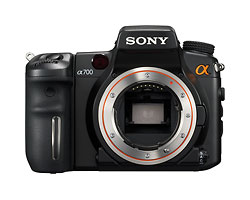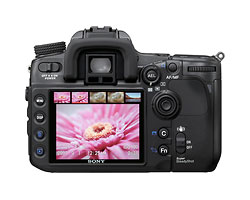Sony finally announced their long-awaited follow-up to their first digital SLR, the Alpha DSLR-A100. It appears to be a solid mid-level camera, with a significant redesign and some valuable feature improvements. At the PMA (Photo Marketing Association) tradeshow, in February, Sony announced they had three new digital SLRs in development: a new entry-level camera, a mid-level body, and a professional digital SLR. Based on the specs and price ($1400 US), the Alpha DSLR-A700 is the mid-level camera.
Image Quality
The most obvious change between the A700 and the A100 is 20% more pixels with the new 12.24-megapixel Exmor CMOS sensor. Twenty percent isn’t a huge resolution increase. But it’s enough to compensate for some cropping and it also puts Sony ahead of Nikon and Canon in the mid-level, consumer digital SLR camera space. Currently, Nikon and Canon’s mid-level cameras, the EOS D40 and Nikon’s D80, each use 10-megapixel sensors. The new sensor should mean better image quality, too. Besides offering more detail and cropping room, increased resolution can effectively minimize noise simply because it reduces the size of the pixels in an image. Sony’s new Exmor sensor also has on-board noise reduction to decrease noise before the data is even sent to the camera’s processor. We’ll have to wait to see the actual, real-world image quality. Better image quality would be good. Because even though the DSLR-A100 had good image quality, it wasn’t as good as comparable cameras from Nikon or Canon. And if Sony wants to take a bigger bite out of the DSLR market, they need to compete with pure image quality. That’s still the main competitive arena - especially on the Internet where people love to compare cameras at a pixel-to-pixel level.
More important than the number of pixels is the increased sensitivity of the new camera. The A700 has a maximum (expanded) sensitivity of ISO 6400, compared to the A100′s ISO 1600. Again – we will have to wait and see what the A700′s ISO 6400 images look like. It’s possible they’ll look like Lego block art. But the fact that the A700 goes to ISO 3200 (standard maximum sensitivity) and ISO 6400 in the expanded mode indicates that Sony has some confidence in the image quality and noise levels of the new camera. The higher sensitivity settings also compare favorably to cameras in the same class. The Nikon D80 has a maximum sensitivity of ISO 1600 and Nikon’s recently announced D300, which is a step above from the A700, has a maximum sensitivity of ISO 3200 and expands to 6400. And Canon’s new EOS 40D has a standard maximum sensitivity of ISO 1600, with expanded to ISO 3200. It will be interesting to see how the Nikon D300, Canon’s EOS 40D, and the Sony DSLR-A700 compare at their maximum ISO settings. In the end, it’s only usable image quality that counts. If the images are too chunky at ISO 6400, then that setting doesn’t mean a thing.
It doesn’t look like Sony has made any changes to their Super SteadyShot in-camera image stabilization. But then again, they didn’t really need to. It already worked great. And I can’t emphasize enough what a huge benefit image stabilization is for photographers of all types. Not only does it do the obvious – help people take sharper pictures in low light and with telephoto lenses. It also means better overall image quality because it allows you to shoot at lower ISO settings because you can use slower shutter speeds and still get sharp photos. Lower ISO means richer, more detailed, noise-free photos. So even though the new DSLR-A700 appears to use the same Super SteadyShot system as the A100, it’s important to mention the benefits again.
Performance
Indicating it was designed for more difficult subjects and sophisticated photographers; the new DSLR-A700 is capable of capturing 5 frames-per-second. It also has a new auto focus system with 11 sensors, as opposed to the A100′s 9-point AF system. The new AF system has a cross-type sensor in the center for the most accurate auto focus performance. This type of sensor has been standard on cameras that professional sports photographers use for a long, long time. Five FPS and improved AF don’t make the A700 a pro body. But it’s a sign that Sony is serious about competing with traditional camera makers in the high-performance digital SLR space. As with the image quality, we’ll have to wait to evaluate real, in the field performance. But in my opinion, Sony is paying attention to the right stuff. Speed and focus accuracy are a couple of things that really bother photographers when they don’t work right. The technology to make cameras faster and more accurate is available and if Sony wants people to shoot action with their Alpha cameras, they need to provide the features and performance that action photographers want and need. Combine better auto focus, a competitive continuous frame rate, improved high ISO performance, and the proven benefits of Sony’s Super Steady Shot anti-shake system and you’ve got a very compelling camera.
Photo Viewing and Sharing
One of the most visibly obvious changes to the new camera is the 3-inch LCD display. The A100 has a 2.5-inch LCD that looked big when the A100 was introduced. But not anymore. The DSLR-A700′s 3-inch LCD isn’t just bigger – the number of display pixels has also been increased by about 25%. So the LCD image quality should be noticeably better. I have also noticed that the product shots of the camera show the LCD display with a row of smaller thumbnails above the main image. I haven’t seen that before on a digital camera and I like the idea of being able to see and navigate through previously shot images without having to change modes. This is a nice, user-friendly touch and shows Sony’s attention to detail.
“High-Def” and “HD” are hot marketing terms right now and camera companies have been quick to apply it to still digital cameras – especially companies like Sony and Panasonic who also happen to make HD TV sets. Sony started selling “HD” cameras early in 2007. What that means is, they offer widescreen format aspect ratio modes, and high-definition television connectivity in their digital cameras. RCA video-out connectors have been available on digital cameras for a long time. But the new DSLR-A700 has an HD-direct, HDMI connector built right into the camera. As far as I know – and I poked around a bit to check – the A700 is the only digital SLR that offers a direct high definition television connection. How important this is to digital SLR buyers remains to be seen. But Sony has the benefit of a lot of dedicated buyers who tend to buy whatever they’re selling. Offering Sony high-def TV owners the option of plugging their digital SLR right into their TV to share photos will likely to clinch the deal for some camera shoppers.
The one hot feature Sony didn’t include on the A700 is a live view mode. Live view allows the photographer to compose with the LCD instead of the optical viewfinder. It’s currently available now on selected Olympus E-System and Canon digital SLRs, allows a photographer to use the LCD for viewing and composing, as most people do with compact digital cameras. Since SLRs have a mirror blocking the sensor to allow for through the lens viewing, Live View is something of a complicated feature. It’s either a bridge feature to encourage point-and-shoot camera users used to using an LCD to make the move to a digital SLR, or it’s a high-end feature for studio and outdoor photographers working on a tripod who find it difficult to use the optical viewfinder. I’ve had two cameras with Live View for testing and I haven’t been inclined to use it with either one. I tested it to check it out. But personally, I don’t find it a very compelling feature. So I think it’s fine that Sony didn’t give the A700 a live view mode.
Camera Build and Controls
The Sony A100 was decent as far as build, feel, and ergonomics go. But it had a definitely bulky, boxy, and flexy feel to my hands. I didn’t have any actual problems with the build or ergonomics. But it just didn’t feel as good as other digital SLRs I’ve used. The A700 has a new magnesium chassis along with weather and dust sealing, so it will be more secure in the rough environments where outdoor and action photographers spend a lot of their time.
In comparing photos of the A100 and the new A700, I also noted that the new body has a dedicated thumb dial exposure control. The A100 had a standard entry-level button control to toggle between the shutter and aperture controls. Adding a second, dedicated exposure control definitely makes the camera a more serious photographic tool. That’s not the only control layout change I noticed. The A100 has two big dials on top of the camera – one for selecting the exposure mode, and the other one for accessing regularly used controls like ISO, white balance, and auto focus. The DSLR-A700 has gone to a single command dial and now has dedicated ISO, white balance, and drive buttons on top right hand camera panel. I actually like the second dial on the A100, so I’m not sure if I like that change or not. On the other hand, it does simplify and clean up the look of the new camera body.
Compare
Sony Alpha DSLR-A100 Photos

Sony Alpha DSLR-A700 Photos:


Conclusion
The Sony DSLR-A100 was and is a fine camera as well as a great first step into the digital SLR market. They were wise to invest in the Konica Minolta lens mount and other Konica Minolta camera technology. It gave them a great platform to build on and as long as they built a good camera, they were guaranteed a built-in market with Konica Minolta SLR owners. The DSLR-A700 proves that Sony has paid close attention to what people think of the A100. A better body, new sensor, better image quality, and improved auto focus make the new DSLR-A700 a solid upgrade for A100 owners and a great buy for Konica Minolta 35mm SLR and DSLR owners. We’ll have to wait and see if it lives up to the promise of the new specs and features. But it sure looks like Sony has done a good job and I’m excited to get one in my hands to see what it can do.
Related Content:
Other Resources:


Leave a Reply